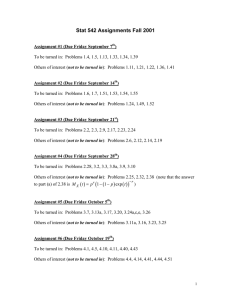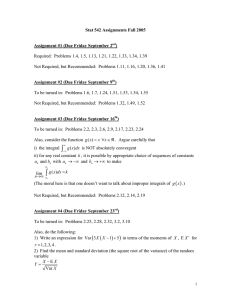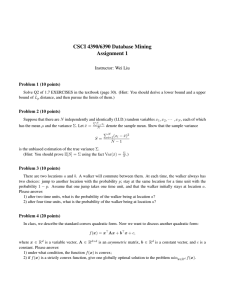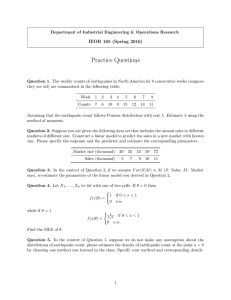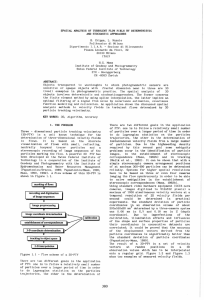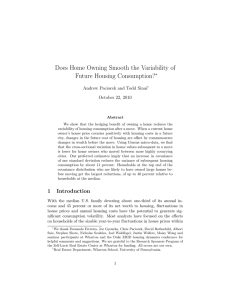Stat 542 Assignments Fall 2001
advertisement
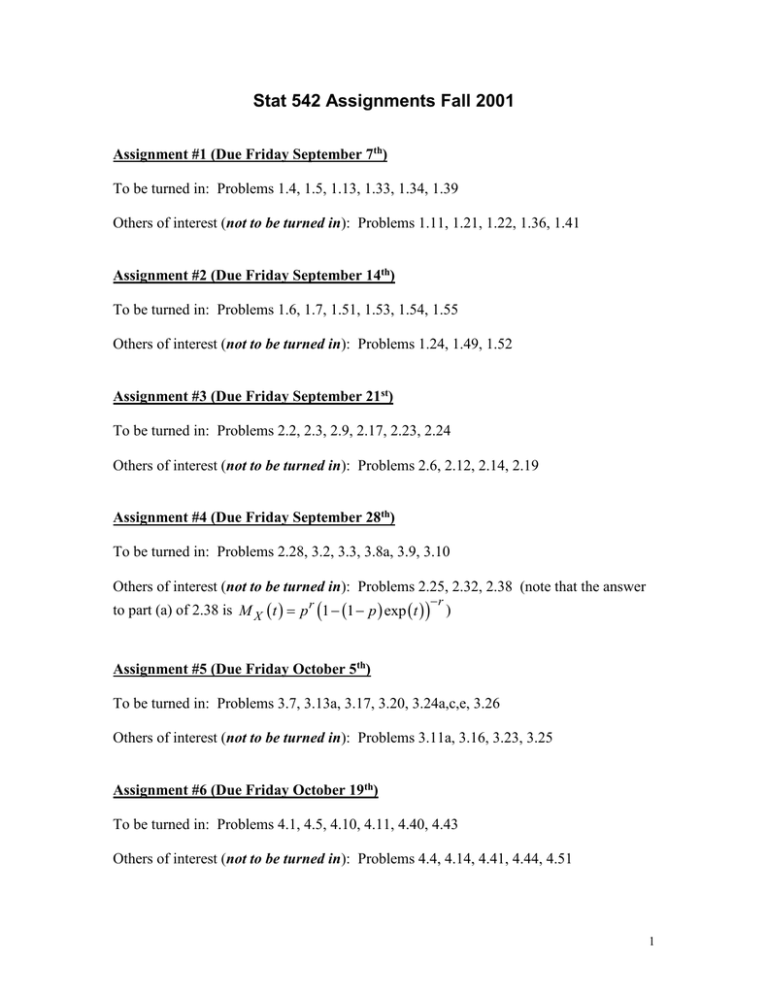
Stat 542 Assignments Fall 2001 Assignment #1 (Due Friday September 7th) To be turned in: Problems 1.4, 1.5, 1.13, 1.33, 1.34, 1.39 Others of interest (not to be turned in): Problems 1.11, 1.21, 1.22, 1.36, 1.41 Assignment #2 (Due Friday September 14th) To be turned in: Problems 1.6, 1.7, 1.51, 1.53, 1.54, 1.55 Others of interest (not to be turned in): Problems 1.24, 1.49, 1.52 Assignment #3 (Due Friday September 21st) To be turned in: Problems 2.2, 2.3, 2.9, 2.17, 2.23, 2.24 Others of interest (not to be turned in): Problems 2.6, 2.12, 2.14, 2.19 Assignment #4 (Due Friday September 28th) To be turned in: Problems 2.28, 3.2, 3.3, 3.8a, 3.9, 3.10 Others of interest (not to be turned in): Problems 2.25, 2.32, 2.38 (note that the answer r to part (a) of 2.38 is M X t p r 1 1 p exp t ) Assignment #5 (Due Friday October 5th) To be turned in: Problems 3.7, 3.13a, 3.17, 3.20, 3.24a,c,e, 3.26 Others of interest (not to be turned in): Problems 3.11a, 3.16, 3.23, 3.25 Assignment #6 (Due Friday October 19th) To be turned in: Problems 4.1, 4.5, 4.10, 4.11, 4.40, 4.43 Others of interest (not to be turned in): Problems 4.4, 4.14, 4.41, 4.44, 4.51 1 Assignment #7 (Due Friday October 26th) To be turned in: Problems 4.7, 4.22 (use the joint cdf and display 4.1.4), 4.30 (for part b, what is the conditional distribution of the ratio given X = x, and what then is a joint pdf?), 4.49, 4.58, 4.59 Others of interest (not to be turned in): Problems 4.13, 4.15, 4.56 Assignment #8 (Due Friday November 2nd) To be turned in: Problems 4.16 (I assume that part c really means pmf, not pdf and I don't follow the note about "Z 0" or "X Y 0" ), 4.23, 4.26, 4.28 (skip part c), 4.32 (the distribution is again negative binomial, but not for the same parameters as in a), 4. 47 Others of interest (not to be turned in): Problems 4.6, 4.31, 4.35, 4.36, 4.37, 4.55 Assignment #9 (Due Friday November 9th) To be turned in: Problems 4.39 (also, in this context, use conditional expected values to evaluate E X 1 X 2 X 3 ), 4.50 and the following: 3 0 1 MVN 3 , with 1,0,1 and 0 5 0 , 1 0 10 find the joint distribution of U X 1 X 2 X 3 and V 3X1 X 2 1. 2. Let X and Y be random variables such that X is standard normal, the conditional distribution of Y given X x is normal with mean x variance 2 and X , Y has a 1. (Lahiri) For X 1 , X 2 , X 3 (joint) moment generating function. 1 1 a) Show that X , Y is bivariate normal with covariance matrix . (Write 1 3 the joint moment generating function as an iterated expectation and evaluate it, finding it to be of precisely the right form.) 3 2 1 X XY Y 2 ? b) What is the distribution of 2 2 c) Is the distribution of X Y , X Y singular, or is it nonsingular? Explain. 3. Find the mean vector and covariance matrix for a k 4 Dirichlet random vector, where the parameter vector 1,2 ,3 ,4 is 1,4,2,3 . Is this covariance matrix nonsingular? (Why is this no surprise to you?) Evaluate P X X .5 . 1 3 2 4. Find the mean vector and covariance matrix for a multiple hypergeometric random vector with N1 10, N 2 40, N 3 20 and N 4 30 when n 10 . n 10 . How do these compare to the mean and covariance matrix for a multinomial random vector with n 10 and p .1,.4,.2,.3 ? Suppose I desire to find a continuous distribution with the same mean and covariance matrix at least somewhat comparable to that of the multiple hypergeometric. Identify both a multivariate normal distribution and something built from a Dirichlet distribution that I might use. (In the second case, you may simply say you'll use the distribution of some particular multiple of a variable with some particular Dirichlet distribution.) Assignment #10 (Due Friday November 30th) To be turned in: Problems 4.63, 5.3, 5.11, 5.12, 5.13, 5.16 Others possibly of interest (not to be turned in): Problems 5.2, 5.10c, 5.15, 5.19, 5.20 Assignment #11 (Due Friday December 7th) To be turned in: Problems 5.29, 5.36, 5.42, 5.44 and the following two exercises. P P Y iff X ni Yi 1. Prove that if X 1 , X 2 , X 3 , are random k-vectors, then X n for all i 1,2, , k . (You'll probably want to use the key points I laid out in class.) 2. (Lahiri) Let X 1 , X 2 , X 3 , be a sequence of iid Gamma 3,1 random variables. n n a) Let X n n 1 X i , Rn 1/ X n , and Tn n 1 X i1 . Find constants a and b so i 1 i 1 a and Tn b . (Argue carefully that your answers are correct.) that Rn P P b) Find limiting distributions for n Rn a and your answers are correct.) n Tn b . (Argue carefully that Others possibly of interest (not to be turned in): Problems 5.18, 5.30, 5.33, 5.34 Assignment #12 (Not to be Turned in) Problems 5.23, 5.24, 5.27a and the following exercises: 1. For X 1 , X 2 , , X n iid with marginal pdf f and marginal cdf F, show that P F X ( n ) F X (1) p 1 p n n 1 p p n1 . 3 2. (Convergence in probability or in distribution says nothing about moments) Suppose 1 P 0 (and therefore that that Yn ~ Bernoulli and take X n nYn . Show that X n n L X n 0 ). Does EX n 0 ? 3. (The "delta method" can be spectacularly wrong when used as a way of approximating moments) Suppose that X ~ U 0,1 . Consider the function 1 and the random variable Y g X . Find the "delta method" x approximation to the mean and variance of Y. How do they compare to the real mean and variance of Y? g x 4. Suppose for sake of example that I am interested in a continuous distribution with pdf f x K x sin2 x for x the standard normal pdf and K some appropriate normalizing constant (that to my knowledge can not be evaluated "in closed form" but that MathCad indicates is no more than 2.32). a) Carefully and completely describe a rejection sampling algorithm for generating X from this distribution. b) Then consider the matter of finding the variance for this distribution. One possibility is simply to generate a large number of iid observations (via the rejection sampling algorithm) and use the sample variance as an approximation for this. Another is to use importance sampling to approximate E X 2 (since by symmetry E X 0 . Carefully and completely describe how to do this. c) Carefully describe two ways of approximating P .3 X 1.2 via simulation. (For the first, suppose that X 1 , X 2 , , X n iid f are available via the rejection algorithm. For the second, consider importance sampling using iid standard normal variables. In the second case, you may want to consider the function q x 1 if x .3,1.2 and q x 0 otherwise .) 4
